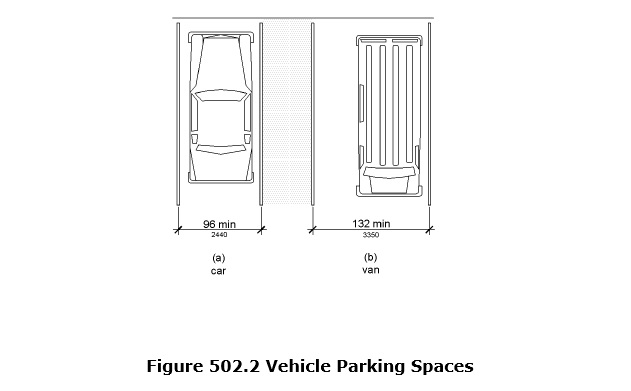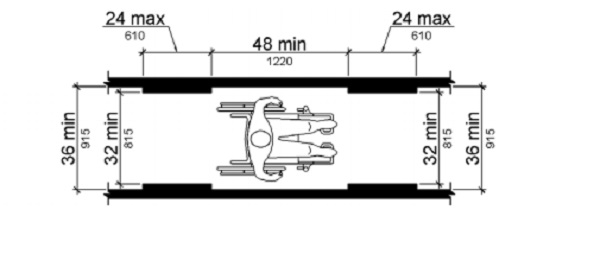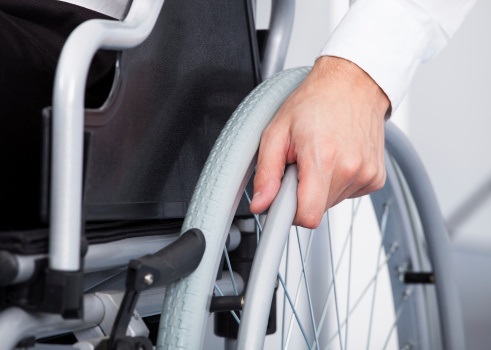Body
Considerations for Adapting a Home for Wheelchair Accessibility
There are several ways to create a more accessible space for a person in a wheelchair. Some options include altering an existing floor plan, building an addition, converting existing rooms, renting a different apartment or home, or buying a new home. The following guidelines may be helpful to anyone planning for wheelchair accessible housing.
Please consult with a qualified Home Modification contractor to ensure full compliance with applicable laws and regulations.

Always measure the width and length of your wheelchair since there are many different sizes.
The dimensions listed below refer to standard-size wheelchairs. Owners of power and reclining models may need to modify the measurements based on the length and width of the chair. It is important to identify specific needs.
General Building Blocks for Adapting a Home
- Minimize and eliminate changes in floor level/transitions
- Provide ample turning space in all areas
- 67 inches in diameter is the recommended standard (International Code Council standard 304.3.1)
- Consider knee/toe clearance under vanities, sinks, work surfaces, eating tables, etc.
- Decrease clutter and provide clear floor space for a wheelchair in all spaces of the home
- Consider height of all appliances, shelving, outlets, etc. to be within reach range from wheelchair level
- Change doorknob hardware to be more accessible (i.e. lever handle)
- Install a ramp or stair lift to enter the home if necessary
Entrance and Exit
Parking: If you use a garage, make sure the entrance is high enough for a raised-roof van and wide enough to allow the use of a wheelchair lift or to make an easy wheelchair transfer. Approximately 96 inches is needed for a wheelchair lift and 60 inches of space is needed for a transfer from the wheelchair.

Note. From: ADA Standards for Accessible Design, 2010. (2010, September 15). Retrieved May 11, 2020, from https://www.ada.gov/regs2010/201n.d.AStandards/2010ADAstandards.htm
Specifications for a ramp or pathway to entrance
- 36-48-inch-wide pathways
- 32 to 36 inches high handrails that extend 12 inches beyond ramp
- Slip resistant surface (non–slip strips, indoor/outdoor carpeting, sand paint)
- Covering for inclement weather
- Ramp materials: wood, concrete, or expanded aluminum
- For every 1 inch of vertical rise, 12 inches of ramp
- Free swinging (no spring or hydraulic mechanism)
- ½ inch or less threshold edge height
Option: electric entrance door opener
- If a ramp is longer than 360 inches, it needs to change direction. With a change of direction, a level platform or landing should be used. The minimum landing size required is 60 inches x 60 inches.
- If there is no room for a ramp and/or the ramp is too steep or unsafe, a vertical lift or elevator may be used.
- Ask your occupational therapist or physical therapist for information on lifts, ramps and elevators.
Interior/General Living Space
Doorways
The minimum 36 inches of continuous clear width of accessible routes can reduce to 32 inches at points, such as doorways, for a maximum distance of 24 inches. Greater clearance is required for 180 degree turns around narrow obstructions and for wheelchair turning space. The minimum clearance cannot be reduced by any elements, including handrails or protruding objects.
**The exact width required depends on the width of the wheelchair. 32 inches wide is the standard minimum recommendation for doorways; however, measuring the width of your personal wheelchair is most important to guarantee proper mobility through doorways.
Options to increase the width of doorways:
- Offset, Z–shaped door hinges
- Remove the frame on the door
- Remove the door itself
- Reverse the swing of the door

Illustration of optimal doorway width
Note. From: ADA Standards for Accessible Design, 2010. (2010, September 15). Retrieved May 11, 2020, from https://www.ada.gov/regs2010/201n.d.AStandards/2010ADAstandards.htm
Door Handle
- 36 inches from floor
- Levers preferred over knobs
Thresholds
- Eliminate if possible
- Use threshold ramp, bevel, or recess
Hallways
- 36-48 inches wide
- Consider using corner protectors/bumper guards
Floors
- Hardwood or tile preferred
- No slip mats or rugs
- If there is a carpet, choose low pile
Outlets/Switches
- 40 inches from floor is optimal
- Levers or rocker switches (if needed to operate with closed fist)
Ramps - see ADA chapter 4 standards
- Slopes follow the 1:12 ratio in rise (example:12 inches of ramp length for every 1 inch of vertical rise)
- 36 inch wide minimum
Telephones
- Accessible in bedroom and bathroom
- Use cordless or cell phone for increased portability
Furniture
- Maintain adequate wheelchair passageway
- Table or work area should have at least 29 inches leg clearance underneath
- Remove breakable objects on furniture
Bathroom and Toilet
- 16 inches or less from floor if commode or shower chair is used over the toilet
- 17 to 18 inches high if pivoting to transfer to toilet
- 30 inches to 36 inches for transfer space on one side, depending on height
- Grab bars can be installed after constructions if walls are properly reinforced
Sink
- 34 inches or less from floor
- If using a pedestal style sink, consider the height of knees from floor to ensure safe clearance
- Open underneath with insulated pipes is optimal
- Lever controls – single faucet preferred
- Adjoining counter space
- Lowered, tilted mirror
Bathtub
- 30 inches of transfer space on side for transfer/bench
- Reinforced walls for grab bars (able to withstand 300 pounds of pressure in any direction)
- Handheld shower
- Grab bars should be 24-30 inches long and 32 to 36 inches high
Roll–in shower
- 60 inches x 60 inches optimal space
- ½ inch or less threshold
- Drain in far corner, 1 inch lower than bathroom floor
- Grab bars on showerhead wall and adjacent wall 30 to 32 inches from the floor
- Soap dish 30 to 36 inches from floor
- Handheld shower adapter able to convert to standard showerhead with diverter button
- Antiscald device so temperature does not exceed 120ºF; protects sensory impaired skin from burns
Kitchen Turning Radius
- 60 inches x 60 inches optimal
Appliances: ensure all appliances are at an accessible height to avoid repetitive overhead reaching.
Countertops
- Optimal height from floor is 30 to 33 inches
- Optimal knee clearance is 27 to 29 inches
Refrigerator
- Side by side models of refrigerators are preferred over vertical refrigerator models.
Sink
- 34 inches or less from floor
- Insulated pipes beneath underside of sink
- Thermostatic control on faucet sink hose
Storage
- Pull out shelves
- Lazy Susan cupboard
- Open shelving
- Track shelving
- Wall mounted peg board to hang pans
Stove
- Mirror over stove to see contents in deeper pots may help
- Stove/oven front controls preferred so it does not require reaching over burners
Microwave
- Place on countertop in area which is easy to reach
Washer and Dryer
- Front loading models offer easier access
Bedroom and Bed
- Firm mattress – 22 inches from floor optimal for transfer from wheelchair
- 36 inches on either side of bed for wheelchair transfer
- May need space for hospital bed
Closet
- Sliding doors
- Rods 48 inches or less from floor
Dresser
- Pull handles or straps
- 34 inches or less from floor
Set Priorities before Starting a Modification Project
Most people work on the major architectural barriers first. Priority is usually: entrance, bathroom, bedroom, and then other rooms of the house. The permanence and quality of modifications depends on the needs of the person using the wheelchair and family, estimated time spent in the home, available finances, and whether the residence is being rented or owned. The following guidelines can help the modification process go more smoothly.
- To avoid over designing, recognize your abilities and disabilities.
- Ask other people with disabilities for advice. They can refer to reputable contractors and give suggestions based on personal experience.
- Know your individual needs. Analyze and operate all equipment before buying to make sure it works for you.
- Use a specialty or standard contractor.
- Try to solve problems with a minimal investment in time and money.
- Always review plans.

References
Americans with Disabilities Act (ADA) Standards for Accessible Design, 2010. (2010, September 15). Retrieved July 8, 2024, from https://www.ada.gov/regs2010/201n.d.AStandards/2010ADAstandards.htm
International Code Council (ICC), 2017. Chapter 3 Building Blocks - 2017 ICC A117.1 with Supplement 1 Accessible and Usable Buildings and Facilities. https://codes.iccsafe.org/content/ICCA117.12017P6/chapter-3-building-blocks#ICCA117.12017P6_Ch03
Yanchulis, D. (n.d.). Guide to the ADA Standards, Chapter 4: Ramps and Curb Ramps. Retrieved May 11, 2020, from https://www.access-board.gov/guidelines-and-standards/buildings-and-sites/about-the-ada-standards/guide-to-the-ada-standards/chapter-4-ramps-and-curb-ramps
This content is for informational purposes only and may not be comprehensive. Information contained does not imply an endorsement from Shirley Ryan AbilityLab, and does not replace the advice of a qualified healthcare professional. See here for further details.
© Shirley Ryan AbilityLab (formerly Rehabilitation Institute of Chicago) Henry B. Betts LIFE Center – (312) 238-5433 .



